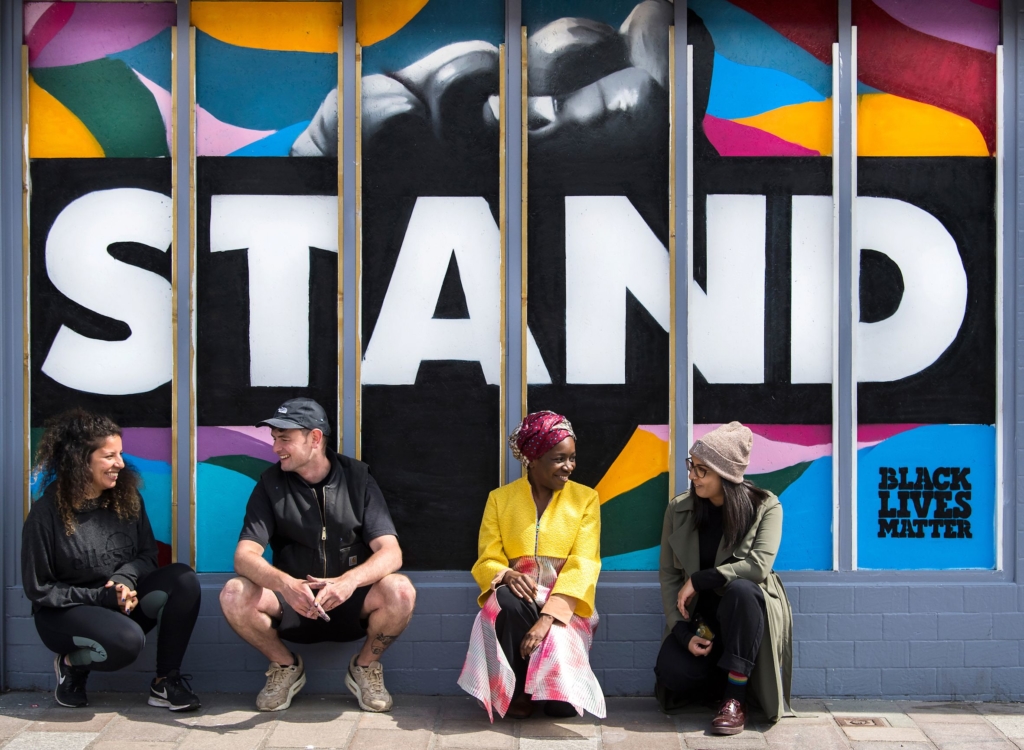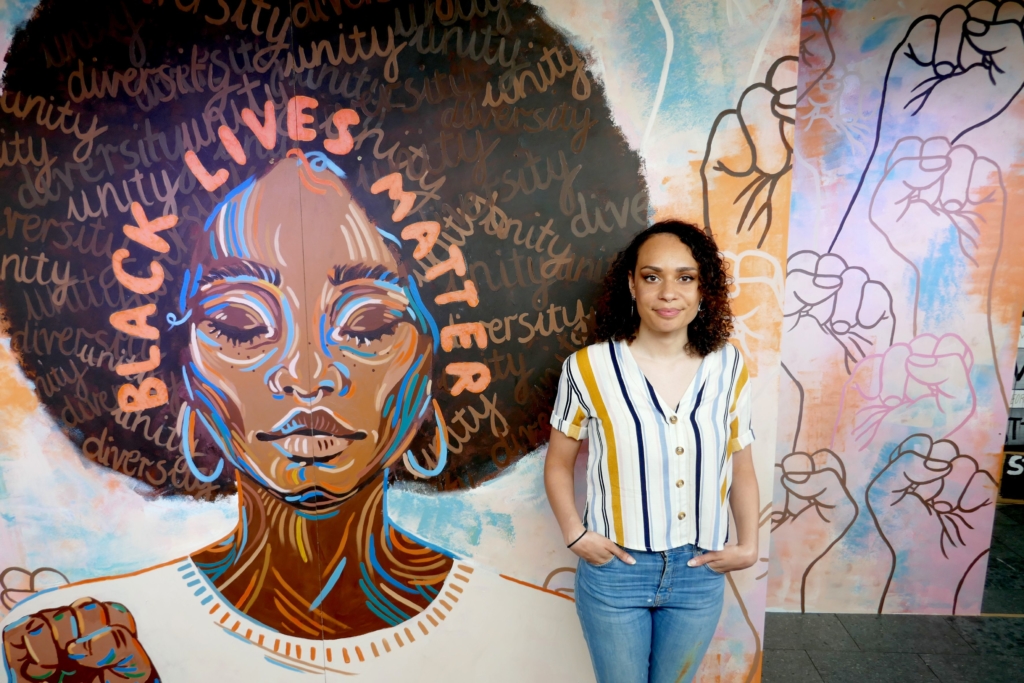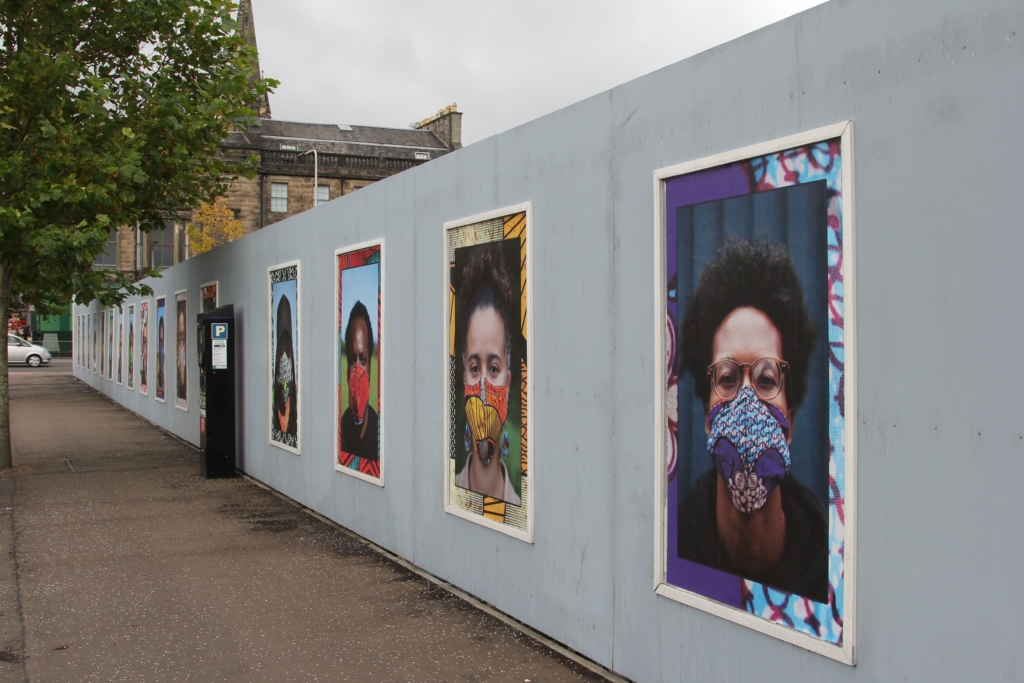On the Black Lives Matter Mural Trail

In mid-June in Edinburgh, as cities around the world swung between fierce protest and eerie silence, a series of photographs went up at The Hub, home of the by then cancelled Edinburgh International Festival. Comprising several black-and-white portraits of a young girl covering her nose and mouth inscribed with the words “I can’t breathe”, the photographs – taken by photographer Jamal Yussuff-Adelakun in collaboration with his daughter Lola Yussuff-Adelakun – were the first in a series of diverse artworks by Black artists that have filled the streets of Scotland over the past few months.
“There was a moment where it felt like the world was listening to our pleas of racial injustice,” Wezi Mhura, the producer of the Black Lives Matter Mural Trail considers, casting her eye back on the events of this summer that precipitated the creation of the trail. “[But] I was very aware that things like protests, or turning your square black on Instagram were a moment that would easily come and disappear. I was very keen to keep the conversation in the public sphere.”
The mural trail, the first of its kind to take place in Scotland, takes its cue from the protests that began in Minnesota after the brutal murder of George Floyd by the police, encapsulating the global scale of racism that Black people endure while also bringing the conversation directly to bear on Scotland’s own legacy of anti-Blackness. “Usually whenever the topic of being Black or the experience of Black people come up, it comes within either an American context or it’s very London-centric or Manchester-centric,” Mhura explains. “The Black Scottish voice is very often forgotten, and actually presumed not to exist.”
Through its inherently public nature, and the sheer number of pieces that makes up the trail – over 40 artworks adorning over 30 sites across the length and breadth of Scotland – the Black Lives Matter Mural Trail counters this silencing and invisibility, offering a nuanced, complex insight into the Black Scottish lived experience, an experience that is so often reduced to simplified narratives. “Every artist that I spoke to, the very first question was, ‘well, what’s the brief, what do you want me to do?’ And I was like, ‘no, this is [about] what you want to bring forward,’” Mhura stresses, adding that she made considerable efforts to seek out up-and-coming, non-traditional artists through community groups and alternative creative channels. “It felt really important for me to not go with the usual ten people that everybody is aware of, but to expand these conversations out to people who don’t necessarily always feel art speaks to or for them.”

The results speak for themselves, emblazoned in striking colour throughout Scotland’s cityscapes and across its arts institutions. An intimate portrait of 19th-century American abolitionist Frederick Douglass by Ross Blair sits across the street from Douglass’ temporary Edinburgh residence, Black Lives Matter fists are boldly painted on the doors of Glasgow’s Glee Club by art group Graffiti Collective, a joyful, tender ode to equality and diversity by arts graduate Jacqueline Briggs occupies Inverness’ Eden Court. Was emphasising this individuality always central to the mural trail?
“I’m so tired of being the voice of Black people in the arts,” Mhura says. “This is a conversation that needs to happen with a lot of people. The conversation that needs to happen in Inverness compared to the conversation that needs to happen in Glasgow compared to the conversation that needs to happen in Kirkcaldy are different things,” she continues, touching on the Justice for Sheku Bayoh piece that currently covers Edinburgh’s Usher Hall. “It was originally intended for Kirkcaldy, and we were told that we can’t put anything that has Sheku’s name there […] because there’s an active case. But for [the artist], it was absolutely about Sheku, it was that local conversation.”
As moving and compelling as the individual pieces in the trail are, they are rendered all the more powerful by the structure of the trail itself, by its collective nature and its presence on established arts institutions and organisations. “[It was] really important that the buildings that the artwork was adorning were the establishment,” Mhura confirms. “It was important that this was a moment of takeover [for] artists of colour. These represented the level of establishment that didn’t see these artists beforehand.”

This is, Mhura explains, decolonisation that is rooted in mass movement and solidarity, rather than individual action. “I wouldn’t pigeonhole the artworks themselves to say that they are trying to get across a message around decolonising the arts,” Mhura says carefully. “They’re all very nuanced, they all have a different point of view, of lived experience. But as a collective they – without a doubt – scream to this idea that the arts in Scotland don’t represent Black artists properly. You can’t do a project around race and equality on established buildings without questioning the ability of that art to help decolonise the spaces that you’re on. The institution, the organizations, the funding bodies, everybody needs to be held to account. Just by its mere presence on these buildings […] the very nature of having so many artists visible, [it] is very much a knock on the door to the establishment to be like, ‘listen, you can’t be saying that we don’t exist’.”
It is this blend of the public and the private, the institutional and the personal, that makes the mural trail such an incisive expression of racial equality. “Taking over public space was really important, because people needed to encounter it. And because of COVID we are encountering our streets in very different ways. All of a sudden, you’re not rushing from one place to another trying to get from work. You took your time to navigate your streets. I see people stop and read the artwork and read the artist bios and then continue a conversation as they’re walking,” Mhura enthuses. “It’s really exciting. There’s a tangible air of change.”
The Black Lives Matter Mural Trail is crowdfunding to support the artists involved in the project – you can donate here.

Good article thanks. In other times, might have stumbled upon these murals, now have to be told.
Details of locations found here https://www.wezi.uk/blm-mural-trail/